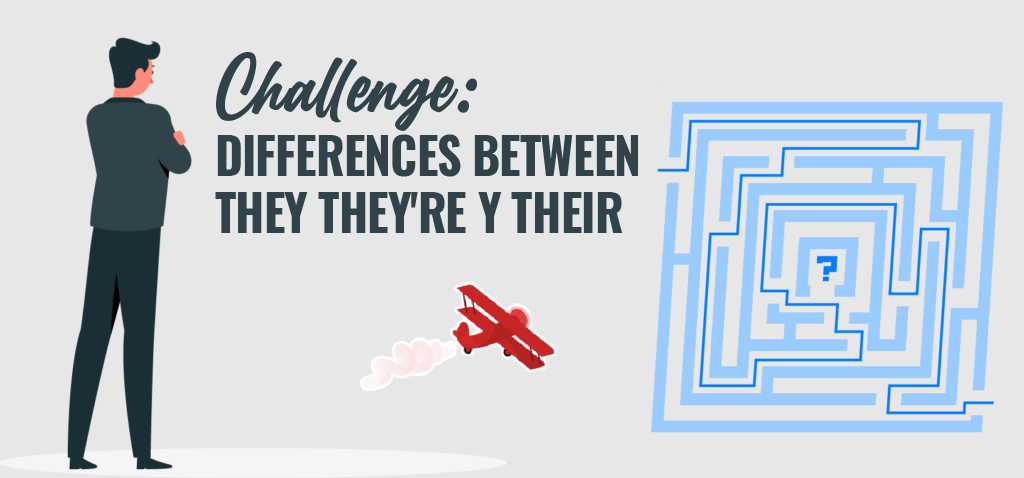CHALLENGE: differences between There, They´re and Their

We all know that English pronunciation can be difficult for a Spaniard, why? The obstacles lie in the different ways between how some words are spelled and how they are pronounced.
ÍNDICE DE CONTENIDOS
In the more phonetic languages, as in the case of Spanish, the words are pronounced as they are written (with occasional exceptions, such as the silent “h” in Spanish).
A very common mistake
Perhaps the most common and therefore the most frequent mistake not only in English learners but also in native speakers is knowing how to distinguish the differences between There, Their and They’re in written English. This is because these three words sound the same when they are pronounced.
Words that sound the same but have different meanings (and sometimes spellings) are called homophones. Therefore There, They´re and Their (Ahí, Ellos, y su, are Homophone words).
Peculiarities of spoken English and Spanish
In languages like Spanish, there is a direct relationship between how a word is pronounced and how it is written. In English, however, how a word is spelled does not necessarily tell the speaker how it should be pronounced. There are many complexities within the English language that affect pronunciation
Their
Let’s start with their (su). It is the possessive form of them, which means that it is used to be able to indicate qualities of property or belonging. Traditionally, there was only used for the third person plural. Today, it is widely used to refer to people who do not identify with a specific gender. They can also be used when the speaker does not know the gender of the person they are referring to.
Example:
- Michael and Lola left their car at home as it was a fine night.
Michael y Lola dejaron su auto en casa porque era una buena noche.
- Their house is big.
Su casa es grande.
- All of their friends were crazy.
Todos sus amigos estaban locos.
- The children put their books in their school bags.
Los niños ponen sus libros en sus mochilas escolare.
There
It is an adverb that is used to indicate position or location. In Spanish, it translates as ahí, allí o allá, depending on the context. It is also used a lot with the verb to be (ser) to indicate the position or existence of something. There can be used as an interjection.
For example, English speakers often say thereafter finishing an action, and there is used to express comfort.
What indicates there
If you are talking about a place or location, then you need the word “there. ” This word indicates where something is going or where it is. There can be used as an interjection. For example, English speakers often say thereafter finishing an action, and there is used to express consolation
Example:
- Michael dropped his coat to the ground. Lola said, “Don’t put it there, Michael. Hang it on a hook.
Michael dejó caer su abrigo al suelo. Lola dijo: “No lo pongas ahí, Michael. Cuélgalo de un gancho”.
- Where is my book? – B: It’s over there.
¿Donde esta mi libro? – B: Está por ahí
- I will look for a hotel to stay when I arrive there.
Buscaré un hotel para quedarme cuando llegue allí.
They’re
There is the contraction of “they are” and is often followed by a noun, an adjective, a present participle (ing), or a past participle (ed)
Example:
- “Where are my parents meeting us?” asked Lola. “They’re meeting us at the restaurant,” said Michael.
“¿Dónde se reunirán con nosotros mis padres?” preguntó Lola. “Se reunirán con nosotros en el restaurante”, dijo Michael.
- They’re happy = They are happy.
Están felices = Están felices.
- They’re very interested in the project.
Están muy interesados en el proyecto.
- I personally think they’re crazy!
Personalmente, creo que están locos!
- They’re singing loudly.
Están cantando fuerte.
Putting it all together
Once you have these three in line, you can easily understand a sentence like this:
- “Their car is being repaired, so they’re taking a cab to get there,” said Michael.
“Su coche está siendo reparado, así que van a tomar un taxi para llegar allí”, dijo Michael.
- Want to improve your English in five minutes a day? Get a subscription and start receiving our writing tips and exercises daily!
¿Quieres mejorar tu inglés en cinco minutos al día? ¡Obtenga una suscripción y comience a recibir nuestros consejos y ejercicios de escritura a diario!
In summary
If you have ” there is ” or ” there are “, then it is always ” there ” (you could never say “they’re is” or “they’re are” or “their is” or “their are”). Therefore, before is or are you must use “there”. Remember that There is / there are is an expression that translates there.



